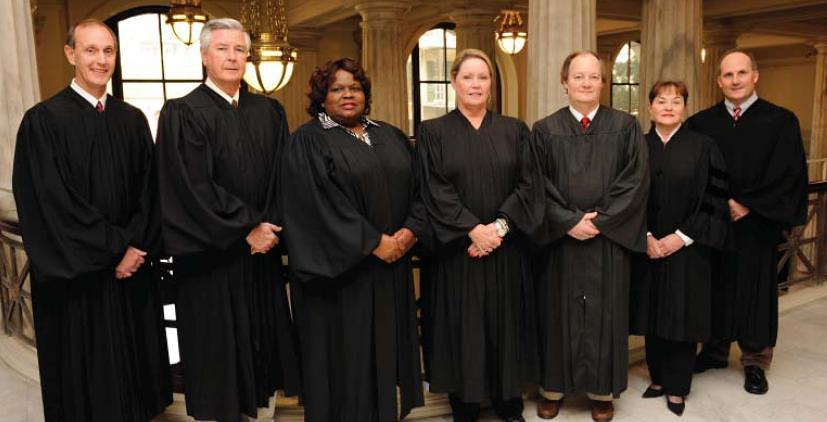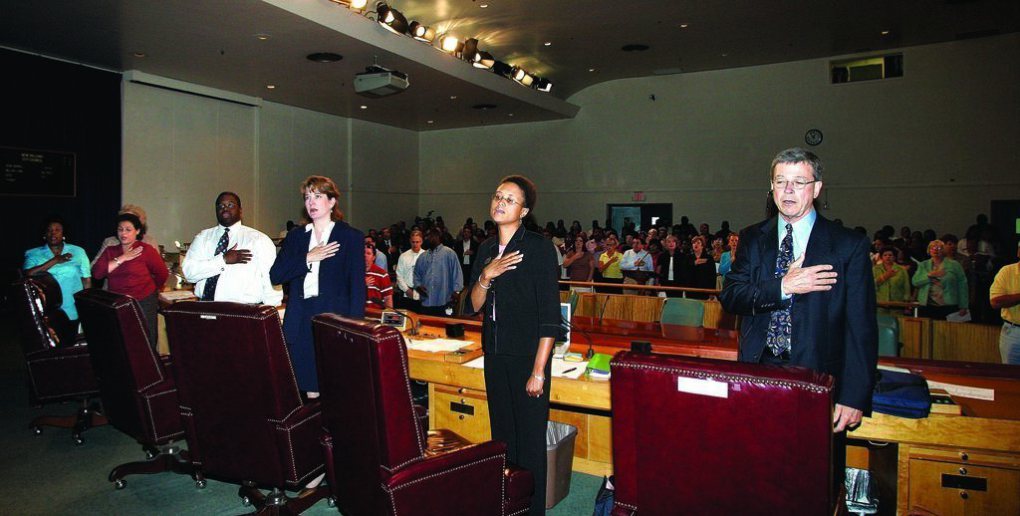On Halloween, the Louisiana Supreme Court dismissed a class-action lawsuit arising from the layoffs of over 7,600 New Orleans school employees in the wake of Hurricane Katrina. The 5-2 decision represented a “stunning, wholesale reversal” for the plaintiffs, who prevailed both at trial and before the Fourth Circuit Court of Appeal; those rulings had found the Orleans Parish School Board (OPSB) and State of Louisiana liable for an estimated $750 million in back pay and damages.
The Supreme Court dismissed the teachers’ lawsuit on the basis of res judicata, the legal doctrine that prohibits the re-litigation of cases that have already been conclusively settled in court. In September 2007, the United Teachers of New Orleans (UTNO) reached a settlement with OPSB over the layoffs, in which the school board agreed to pay $7 million in compensation to members of the UTNO bargaining unit (about $1000 per member). In exchange, UTNO agreed to file petitions to withdraw and dismiss all of its pending cases against the district. Since the causes of action asserted in the teachers’ lawsuit arose from the same issues addressed in this earlier “global settlement” between UTNO and OPSB, the Court ruled:
“The UTNO dismissals with prejudice were all rendered by courts of proper jurisdiction, after proper notice, and disposed of the merits in whole or in part. Both a dismissal with prejudice and a settlement are ‘final’ adjudications for the purposes of res judicata.”
However, the high court’s ruling in Eddy Oliver, et al. v. Orleans Parish School Board 1 [see full text of the opinion below] went a step further to definitively settle the broader question of whether OPSB and the State had broken the law, declaring that “neither the OPSB nor the State defendants violated plaintiffs’ due process rights.”

The court’s decision sheds new light on one of the most controversial and misunderstood events to emerge in weeks and months after Hurricane Katrina. Over the years, critics of the RSD’s takeover have sought to portray the layoffs as part of a concerted strategy to disenfranchise community members and replace the school system’s largely African-American teaching corps with outsiders drawn from the ranks of organizations such as Teach For America and teachNOLA.
Although critics provided little evidence to support these accusations, the belief that local and state education officials conspired against the district’s veteran teachers has served as a lingering source of resentment in the community. In recent months, when it appeared that plaintiffs might prevail in court, pundits such as education commentator Andre Perry, suddenly began embracing these conspiracy theories as fact. For example, in an op-ed in The Lens in October, Perry placed the blame for the layoffs on education reformers, while conveniently ignoring his own role in the city’s school reform efforts as CEO of the Capital One-University of New Orleans Charter School network from 2007 to 2011:
“Many in New Orleans believed that locals didn’t have the capacity to make needed changes to the school system…The architects of education reform in New Orleans did not trust the managers, employees or consumers of the prior system.”

Nevertheless, in his opinion for the majority, Justice Jeffrey Victory provides a full accounting of the facts in the case and methodically picks apart many of the prevailing myths surrounding the layoffs. Below, I address each of these myths and borrow findings from Justice Victory’s opinion to demonstrate that the layoffs were not only legal, but unavoidable given the extensive damage to schools, the mass displacement of city’s population, the precarious financial situation of OPSB, and the RSD’s takeover of all but a handful of the city’s schools.
Three Things To Know About The Teacher Layoff Case – September 4, 2014
Myth #1. Education reformers orchestrated the layoffs in an attempt to get rid of veteran teachers
In a statement under the heading A pre-Katrina political agenda on nopsejustice.com, the website established for participants in the class-action lawsuit, attorneys for the plaintiffs accuse the seven members of the Orleans Parish School Board of carrying out a pre-conceived plan to turn the district’s schools into charters:
“Political newcomers to the OPSB used Hurricane Katrina as a once-in-a-lifetime opportunity to carry out an old political agenda to abolish the New Orleans Public School System as it existed before Hurricane Katrina, and replace it with quasi-private, Charter Schools, using public funds.”
In spite of this sinister portrayal, it would be hard to characterize the majority of the school board’s members at that time as pro-charter reformers. In reality, the board had a contentious relationship with reform-oriented State education officials in the months leading up to the storm, so the suggestion that the board endeavored to carry out “an old political agenda to abolish the New Orleans Public School System” doesn’t hold much water.

Regardless, the timeline of events leading up to the layoffs [see timeline below] makes clear that the district’s dire financial situation made the layoffs all but inevitable. By 2005, OPSB had amassed $265 million in debt and the U.S. Department of Education had threatened to withhold federal funding unless an outside firm was hired to manage the district’s finances. As a result, OPSB signed a contract with the turnaround firm Alvarez & Marsal in July 2005. In an initial report released just weeks before Katrina, Alvarez & Marsal auditors exposed the serious financial problems facing the district:
“The conditions we have found are as bad as any we have ever encountered. The financial data that exists is unreliable, there has not been a clean audit since FY 2001-2002, there is no inventory of assets, the payroll system is in shambles, school buildings are in deplorable condition and, up to now, there has been little accountability.”
At its first board meeting after the storm on September 15th, 2005 – before the State made any move to takeover schools – OPSB placed employees on disaster leave without pay “as a result of Hurricane Katrina given the emergency closure of all schools and the subsequent lack of revenues.” OPSB placed teachers on unpaid leave because the district only had enough money to pay employees for their work through August 29th, the day the Katrina hit New Orleans. Thus, by mid-September, OPSB was effectively bankrupt and there was no local tax revenue in the offing with the city all but empty.
On November 30th, Governor Kathleen Blanco signed Act 35 into law, allowing the RSD to takeover 102 of the 126 public schools in Orleans Parish. Of the 24 remaining schools, 7 were uninhabitable, 12 became OPSB-authorized charters, and 5 remained under the direct management of OPSB. As a result, OPSB’s $17 million per month in Minimum Foundation Program funds from the State thereafter shifted to the RSD.
OPSB was now out of money and only in control of five of its original 126 schools. The district had no other choice but to begin the layoff process. The same day Governor Blanco signed Act 35 into into law, Acting Superintendent Ora Watson issued a press release which advised all OPSB employees that they were terminated, saying the board’s “actions became necessary, first by the Katrina disaster, and then by the State having recently created a recovery district with responsibility for most of the schools that had been under [OPSB] control.”
Myth #2. There were teaching positions available for returning teachers after the storm
The catastrophic levee failures during Hurricane Katrina led to the flooding of nearly 80% of the City of New Orleans. An initial investigation of New Orleans’ 126 schools after the storm found that 118 received serious wind and/or flood damage, and of those, 80 buildings would likely need to be torn down and rebuilt. Only eight schools in the entire district survived the storm unscathed.

Given the extensive damage to the city’s schools and the mass displacement of city’s population, it was clear almost immediately that most of the district’s 7000 teachers would not have jobs to return to in the weeks and months after the storm. In fact, 10 years later, the city’s public school enrollment stands at 45,000 45,608 – far less than the approximately 60,000 students enrolled in OPSB schools in August 2005.
In his opinion, Justice Victory points out that only a fraction of the teachers represented in the class-action lawsuit could have feasibly regained employment in the district:
“Due to the unique issues presented by Hurricane Katrina, had a recall list been in place, there were only 526 positions available for the over 7,000 class members here. There is no legal theory which would allow over 7,000 teachers to recover back pay when only 526 could even theoretically be able to show they would have been hired if a recall list had been in place.”
In short, even if OPSB had been able to conduct a proper recall process, less than 10% of the district’s teachers would have secured a teaching position during the recall period. As Justice Victory noted, “It would defy logic to find the OPSB liable for a due process violation where jobs were simply not available.”
Myth #3. State officials plotted to fill teaching positions with Teach For America corps members
Prior to the storm, Teach For America – Greater New Orleans placed the majority of its corps members in New Orleans, although smaller contingents taught in schools in Jefferson and St. John the Baptist Parishes. When schools reopened in Jefferson and St. John a few weeks after the storm, corps members working in those parishes returned to their classrooms. However, corps members working in OPSB schools were laid off along with the rest of the district’s teachers. As a result, approximately 30 corps members relocated to Texas to help open New Orleans West College Prep, a K-8 charter school that served over 350 New Orleans students evacuated to Houston after Katrina. Several dozen more corps members were recruited to work in FEMA Disaster Recovery Centers across Louisiana.

As I’ve noted in previous blog posts, I worked on staff at Teach For America – Greater New Orleans from June 2004 to June 2006, and I was involved in a number of internal staffing and placement discussions in the months after Hurricane Katrina. In the first half of 2006, it was unclear how many schools would reopen in the fall due to the tremendous uncertainty about when (or if) families would begin returning to the city. As a result, we decided to bring in only a dozen new corps members to the region for 2006-07 school year, down from approximately 70 in 2005.
As Justice Victory notes in his opinion, the RSD didn’t sign a contract with Teach For America until the 2007-08 school year, when the district hired approximately 125 corps members. The fact that the RSD turned to TFA to help staff schools as time went on happened because of the difficulty RSD encountered in staffing schools, not because of a behind-the-scenes plan to replace former OPSB teachers with TFA corps members.
Myth #4. The Recovery School District was legally required to hire tenured teachers who were laid off by OPSB
Plaintiffs claimed the State of Louisiana violated their due process rights because the RSD did not give preferential treatment to OPSB teachers when hiring for positions in the schools taken over in November 2005. In arguing that the RSD was obligated to give hiring preference to these teachers, attorneys for the plaintiffs pointed to a clause in Act 9, the original state takeover law passed in 2003, which states:
“At the time of the transfer of a school to the school district [RSD], any certified teacher with regular and direct responsibility for providing classroom instruction to students who is employed in the transferred school by the prior system shall be given priority consideration for employment in the same or comparable position by the school district.”
The State’s culpability hinged on the meaning of “priority consideration,” a vague term which had never been clearly defined. In its opinion, the Court stated that “priority consideration” is exactly that – just consideration, no more, no less:
“The RSD is not required to hire any of these teachers, and is not required to hire any of these teachers in preference to any other applicants: it must simply give them priority ‘consideration.’ There is no due process claim in a procedure concerning employment that does not require a mandated outcome.”
As to the question of whether the RSD gave “priority consideration” to former OPSB teachers as required by law, Justice Victory points out that the RSD did in fact give preference to former OPSB teachers who had passed an initial screening test:
“The evidence showed that the RSD did give priority consideration to former OPSB teachers pursuant to a process whereby all applicants took a skills assessment, and those OPSB employees who passed were placed in a separate pool to be considered before any of the non-OPSB employees who passed the test.”
So Where Does That Leave Us?
Like tens of thousands of New Orleanians in the weeks and months following Hurricane Katrina, the city’s teachers were left asking the unanswerable question posed to everyone whose life is suddenly and irreversibly altered in a disaster: Why did this happen to me? After all, it’s a bewildering experience to realize how quickly the vicissitudes of fate can snatch it all away from you: your house, your job, your family, your neighbors, all washed away in a deluge of biblical proportions.
So when the teachers union and their lawyers came forward with a conspiratorial narrative that accused state and local officials of stealing their jobs – and more importantly, gave teachers a means to seek redress for that loss – it’s understandable why so many people bought into the story. In some ways, it’s easier to believe that those in power conspired to take your job than it is to accept that a confluence of factors outside of anyone’s control led to that painful result.
Sadly, the myths about the teacher layoffs have been used by opponents of the city’s post-Katrina school reforms as a means to divide the community among racial, generational, and socio-economic lines. They have portrayed reformers as blaming veteran teachers for all the problems in the school system before the storm. They have attempted to gain political clout by exploiting people’s pain.
So let’s clarify one last important point: Ten years after the Katrina, the city’s public schools have vastly improved, but not because so many veteran educators lost their jobs. They’ve improved because the city’s broken public education system, a system that had long failed both students and teachers, was finally washed away.
Timeline of Teacher Layoff Events:
- Interestingly enough, lead plaintiff Eddy Oliver was a long-time operative in Congressman Bill Jefferson’s political machine, the Progressive Democrats. He was appointed as principal of Morial Elementary in exchange for his help getting Betty Jefferson elected to OPSB in 1993. He later testified in court that served as the “front man” for a consulting company run by Mose Jefferson and “routinely signed blank checks and falsified documents at Jefferson’s request, no questions asked.” ↩


you don’t know squat about where I teach though.
Um..@audhilly Mr @petercook was there before and after Katrina. The decisions were led locally. He’s documented that as well.
tbh people from NOLA have written expensively as have journalists @PatrickRGibbons
Not as “light” as where you teach.
some people say it became decidedly lighter and more out of state. Is that false?
I don’t really care what it looks like to someone w/ little understanding of the situation, to be totally honest @PatrickRGibbons
if the teacher was unqualified, then release them upon review. Anything else looks like carpetbagging
In many cases it was.
don’t scream. If you opened a school w a teacher in front of kids, it should have been a teacher from that community.
no schools, no homes, no jobs. The students, the parents, the teachers left. Even the NBA team came to OKC.
THERE WERE NO SAME KIDS. Do you not get that?!?Everything was destroyed. The schools were in ruins. @PatrickRGibbons
I lived in OKC at the time, and I can tell you most of the teachers were not returning. They were in OKC or TX already
Not according to Act 9, which voters passed back in 2004 @PatrickRGibbons
a teacher who didn’t get a job back and another teacher was hired to teach the same kids was fired wo cause.
and the recovery district was not obligated to hire back those teachers. So no harm, no foul?
Yes, that wasn’t aim of the takeover. @PatrickRGibbons
are you saying that act 35 which only applies to NOLA wasnt used to fire teachers and hire TFA replacements?
Can’t have a teacher of record when the schools no longer exist. Katrina wasn’t just some a heavy downpour. @PatrickRGibbons
so, are you saying that the faculty in schools in NOLA didn’t hire TFA members instead of five jobs back? @PatrickRGibbons
No TFA should have replaced a teacher of record.
Again, you’re just chattering away w/o command of the facts. @PatrickRGibbons
You should stop talking until you have all the facts – you’re just pontificating w/o any tether to reality now @PatrickRGibbons
if only that is the way it actually works… but seriously please read Peters blog.
if there were teachers who didn’t do their jobs they should have been addressed.as individual teachers
I’m act 35 was reprehensible misuse of power. Teachers should have come back to their jobs when schools opened
1) I strongly discourage reading Naomi Klein. 2) Peter has a blog post to clear up that misunderstanding too.
Act 35 was disaster capitalism. It is a strong message to the public that they must be vigilant in self defense
The court addressed the due process claim in the ruling. You should read it instead of trying to refute ASAP @PatrickRGibbons
The case couldnt be relitigated after compensation. What’s that proving other than they already got damages? @petercook @PatrickRGibbons